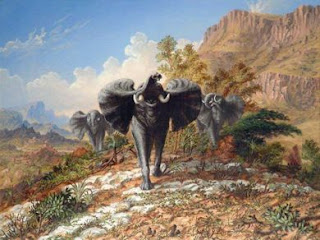The art of South
Africa is fascinating. From colonial times to the present, South Africa has
remained culturally and racial diverse; this diversity carried over into their art. Primitive cave paintings gave way to the colonialists' realistic approach, and modern paintings ultimately found profound influence from ancient cave art. Music in South
Africa was not much different, traditional forms of music adopted new and
diverse forms of music from around the world. To this day, popular and unique
musical compositions stem from South Africa. The art is as
diverse as the people.
South Africa holds the richest collection of rock art in all of Africa.
Some of the most profound ancient artwork is found in Drakensburg, where the
old hunter gather tradition of the San Bushmen is revealed.
All Images in Post: http://www.southafrica.info/about/arts/art.htm#.V0iE6UKqxkg
 |
| Ancient San Bushmen Cave Painting |
This is profound
when we consider that these paintings are approximately 4,000 years old. This
means the San Bushmen occupied this region long before they were driven out by the
colonialists who brought more modern, realistic art with them.
 |
Colonialist Art: "Elephants Charging over Quartos Country" by Thomas Baines |
South Africa also has a rich heritage of intricate bead art. Much younger in its adoption, bead work reveals much about the dress and ornamentation of the region's past. Clearly, the people of the region had a liking of jewelry and personal ornamentation. Archaeologically speaking, this, coupled with the cave paintings, reveals that South Africa had a developed civilization prior to colonialism. Much like the cave paintings, beadwork has survived and is quite popular and influential beyond the borders of South Africa. Some beadwork is even considered fine jewelry and can carry very high prices in international markets.
 |
| Traditional Bead Art. |
While the art of South Africa reveals much about its history, it reveals more about its current culture. As Dr. Joseph E. Harris says,
"Although the early humans in Africa to a great extent were preoccupied with
the bare necessities of physical survival, they also found time for
aesthetic expression...All of these paintings and engravings not only attest to
prehistoric Africans' artistic knowledge and style as well as their
developments with durable paints, but in addition, valuable data are provided
about their life, history, and their environment..."[2]
[2] Joseph
E. Harris, Africa and Their History (NY:
Meridian Books, 1998), 30-31.
References:
"Arts and Culture: South African Art." South Africa Info: January 2014. (Accessed May 26, 2016).
"Arts and Culture: South African Music." South Africa Info: 2015. (Accessed May 26, 2016). http://www.southafrica.info/about/arts/music.htm#.V0jahEKqxkg
Harris, Joseph E. Africa and Their History. NY: Meridian Books, 1998.
"Arts and Culture: South African Art." South Africa Info: January 2014. (Accessed May 26, 2016).
"Arts and Culture: South African Music." South Africa Info: 2015. (Accessed May 26, 2016). http://www.southafrica.info/about/arts/music.htm#.V0jahEKqxkg
Harris, Joseph E. Africa and Their History. NY: Meridian Books, 1998.
